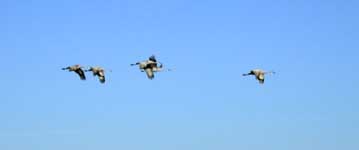
Before you can do any boat repairs in Guatemala, you first have to get there.
I left home at 10:00 on November 18, feeling somewhat lost. Stopped at Steve and Andrea's to drop off leftover milk and a few extra requests for Adin -- water the tomatoes, where the extra cat food is, check the light in Prince Charming's box. Andrea gave me a big hug before I left. Unexpected but very much appreciated. I love that family a lot.
Snow packed 141 to Avon, then mostly clear to Garrison. In short order I was out of snow. 8 inches at home, nothing along the Clark Fork. From winter to fall.
Soon discovered I forgot to put the apples in my provisions, so all I have is cookies, crackers, dried fruit, trail mix, O.J. and chocolate milk. It could be healthier...
Road trips are great for thinking. What makes my boat different from someone else's second home? As a symbol, maybe not much. It's a second home for me, in an exotic place. As a practical matter, it's more like a lumbago. Except it doesn't eat fuel the way a motor home does, at least not with me as captain. But it's not so easy to be righteous when you think about it that way.
As I drive into Butte my eye finds the humongous statue of the Virgin Mary high on the mountain to the east. It's so incongruous -- it looks like a huge phallic symbol. Perhaps it really is appropriate for a rowdy mining town like Butte, full of hypocracy.
As I head east from Billings, I look at the boundless horizon of hills and buttes, and think about how hard it must be for native Americans to come to peace with the knowledge of what was taken from them. How could they not be angry? I don't think I could be at peace with it. I look at the hills again, cross the Little Big Horn. Once this was buffalo country; now it is fenced. Look at what they lost.
A shooting star falls straight down on my right. I mark it as a good omen, like the eagle in the tree at the house a few days ago.
I am passed by many cattle trucks. Cattle country is pouring out its calves, paring down for winter. Will it be a hard one? It's long overdue, and would be welcome.
I listen to "Making Contact" on NPR; the topic is media press reform. I am impressed that there is such a well-formed movement to take back the press.
I'm melancholy again. Is the boat some form of self-imposed exile? I hope not. I realize I haven't written that I want to be cremated in my will. Where do I want my ashes spread? From some high point in the Scapegoat, over the North Fork headwaters.
I pull off about midnight to sleep a little, tossing futilely like a contortionist trying to find a comfortable position. Under my two blankets, with my jacket over my head for warmth. The wind howls, rocking the car, toying with it. What kind of wind would it take to roll it?
In Denver, I changed horses and picked up my folks. From there we took the Queen Mary down to New Mexico, where we spent the night in Socorro. On the way down, we passed a church on our way into Walsenburg to get gas. I noticed the modern spire at one end, sticking up majestically, a giant lightning rod. Something to direct a lightning bolt from God, appropriately focused on a house of worship. Many highly religious people today seem to be particularly self-righteous, and some of the more hypocritical people I have run into anywhere. Read the bible or the koran one day, and abuse people and the earth the next. What an example for our children and grandchildren.
Somewhere in there we would turn off if we were going to Sante Fe. What does Santa Fe mean? How did it get named? Saint Fe? Who the hell was Fe? All I can think of is an iron bar. Aaaaah. It means faith. The saint of faith? I think me Spanish needs work...
There is a crane festival in Socorro, sponsored by the Bosque del Apache Wildlife Refuge. I was surprised to learn the rufuge itself was the sponsor. The next day we detoured and spent an hour at the refuge, watching cranes and snow geese. There were thousands of them, and it was a delight. I could have spent the whole day there, snoozing under a tree and hiking around. There were bazillions of Sandhill Cranes, bazillions of Snow Geese, and gazillions of Canada Geese. The noise was a delight. I can only imagine what it must have been like two hundred years ago.
 |
| Sandhill Cranes at Bosque del Apache |
 |
 |
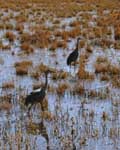 |
| Sandhill Crane at Bosque del Apache |
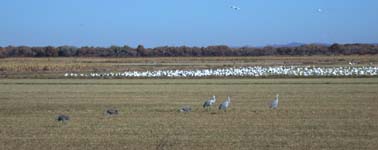 |
 |
| Gazillions of Snow Geese | Bunches of Cranes |
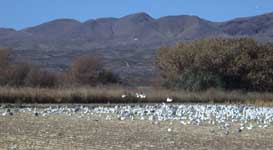 |
| Snow Geese and Sandhill Cranes at Bosque del Apache |
Then we took the winding scenic route over to Silver City. Rugged terrain, a twisting road hugging the steep sides and ridgetops, from desert up to ponderosa pine forests. Narrow and curvey, it would have been a kick in the pants on a bike or in a sports car, but it was still fun in the Queen Mary. Not a single creek bed, low or high, had any water in it. This is dry country, in dry times, at the end of the dry season.
 |
| Road to Silver City |
Southern Arizona, the Geriatric State. Geesus. Talk about depressing. Row upon gently curving row of nearly identical stucco houses, all decorator perfect, resting beneath a smoggy haze. Absolutely no character anywhere except inside the identically decorated southwestern stucco boxes. Ok individually, but mind boggling when taken as a whole. Geriatric city, no kids playing outside, few restaurants, few stores, just mile upon mile of houses and golf courses.
After Thanksgiving festivities, mom and dad dropped me off at a Mexican bus station in Phoenix. I was making this trip to convert Malakii's ice box to a proper refrigerator. The airlines, paranoid as usual, wouldn't let me take the refer parts with me. They only weighed 23 pounds, and easily fit in a suitcase. But they were pre-charged with R-134a, a freon substitute which is not explosive. It was pressurized gas, but the pressure was pitifully low, hardly enough to damage my bag, let alone a whole airplane. But the airlines never let details like that deter them. Air freight, FedX, UPS, everything else all cost $400 or more. And I didn't know anyone sailing down. So I was taking the bus, where things are more reasonable.
An emotional parting with mom and dad and Dave at the Americanos bus station in Phoenix. My mind flashed with thoughts of whether I would see them again. With each meeting, our mortality is more in my mind.
The plan was simple. Take a bus down the center of Mexico to Mexico City. Take another bus to the Guatemalan border. Take another bus to Guatemala City. Take another bus to Rio Dulce. Take a boat to Gringo Bay, where Malakii is.
It sort of went that way. I get on the bus; three hours early. Ok by me; it beats sitting around waiting. The bus heads south, and keeps on going. I thought we were supposed to turn east towards El Paso, then south from there. At least that's what I remember from what the woman on the phone at the bus station told me two days ago. El Paso to Chihuahua to Mexico City. But the map, it turns out, is sitting at home on the kitchen counter, and the woman apparently wasn't talking about this bus. This particular bus is headng straight south to Nogales. Ok... I can live with that, as long as we go south and end up in Mexico City.
To paraphrase Joni Mitchell, we've paved the Sonoran desert and put up an old folks' subdivision. For miles, as we roll south.
I'm reading a National Geographic that has an article about long-lived people. Diet -- nuts, tomatoes, zuchini, fish, mizo, red wine... small portions.
Southern Arizona is pancake flat, with ragged mountains jutting out of the valley floor as if generated by a computer that doesn't know about foothills. Saquaro cacti appear here and there, as if placed by a giant in a model landscape. The mountains rise in the distance like ghosts out of the dust, phantoms resting on a cushion of brown cotton candy. Crossing this plain 200 years ago would have been a careful undertaking.
Golf courses in the desert, a travesty of monumental proportions.
Sustenance for a bus journey -- banana, raisins, trail mix, dried fruit, rice crackers, cumquat, granola bar, junk ritz, junk fritos. It's a wonder Americans live past 40, given our diet of junk food.
We stop on the US side of the border, for exercise or to stretch our legs or for the faint of heart to abandon ship. Since I'm the only gringo on board, that seems unlikely. I change some money; my emergency stash of pesos is, of course, on the boat.
We drive across the border and stop at Mexican customs. A customs man gets on and gives a big spiel in Spanish, where I understood "suitcase" and "green" and "red". When he was done I tapped him and said "No comprendo." He doesn't even miss a beat, switches to English and asks if I have baggage, I say yes, he says what, I say boat parts, he says how much, I lie and say a couple hundred dollars worth, he says I'll have to pay customs, I say even if I'm only in transit to Guatemala, he says where are you going now, I say Mex City, Tapachula, Guatemala, Rio Dulce, he says you don't have to pay.
Everybody gets off, the bus driver opens the cargo doors, and everybody grabs their bag and lines up. Except me. My bag isn't there.
I tell the driver; he looks a bit distressed. He askes me for my claim ticket; by some miracle I can produce it, and give it to him. He runs off to talk to somebody somewhere.
I wait, trying to be patient. Everyone else is through customs, and back on the bus. They stare out the window at the gringo who is holding things up. I take some deep breaths and tell myself it is ok. If I lose all the boat parts I will just change the goal of this trip from boat repairs to something else. It won't be a huge financial loss, but I'll have to make the damn bus trip again. That will be a royal pain in the butt, literally.
After about five minutes, the driver reappears, and motions me to follow. We run back to the border fence, the cage, the rim of the sardine can which separates Mexico from the US.
Magically, my bag appears. It trundles through the turnstile almost as if self propelled. It's still locked. So what was it doing all this time? Who took it off the bus on the US side, and why? Only the bozos in Homeland Security probably know. I grab it and we hustle back, dutifully pressing the button and fortunately getting the green light, much like the desert turnstile in Blazing Saddles, until we got back to customs, where I open the bag. The customs man minimally paws through it, without disturbing my carefull packing, and asks me where I am going. I say Guatemala, Rio Dulce, he says ok, you're in transit. I throw the bag under the bus, the driver says something about there being a travel God, I agree, and we roll on.
I have vague questions in my mind. Noone even asked for my passport, or that of any of the Hispanic travelers, whether they are Mexicans or US citizens.
We're off, with an English movie dubbed in Spanish, I get maybe one word out of ten.
About 40 km down the road, well into Sonora, we come up to another immagration toll booth; they wave us through after the driver makes a hand motion that looks like pouring a drink.
We roll on into the evening. Pretty country flashes past, lacking the Arizona suburban sprawl, but decorated in toilet paper, plastic bags, and a wealth of other roadside trash. The air looks cleaner for some reason, perhaps from the lower angle of the sun, or the lack of wind stirring up dust. We pass some large expanses of greenhouses, packed in like row houses. I see a roadside trash barrel, and to my surprise the roadside is clean. There is hope... It gradually turns black outside, and I fall asleep.
I wake up. It's as hard to pee on a Mexican bus on a Mexican freeway as it is on a boat beating into a stiff breeze.
We come to a place called Hermosilla. A map, or a knowledge of geography, would be useful. We have to change busses. They tell me to change my ticket and wait 20 minutes for a first class bus. No extra pesos, so apparently I already paid top peso.
On the new bus, a movie starts; Pearl Harbour, and it is good. But difficult for me to watch. A slaughter of any kind is gut wrenching.
At ten in the evening we stop for 20 minutes someplace, to eat dinner. When we get back on, the bus won't start. All the guys who think they're macho get out and push. I get out too. Backwards. Forwards. Backwards. Forwards. It's a good thing it isn't raining and muddy. Amber and Erik and Peanut know about pushing buses south of the border in the rain and mud. Backwards. Forwards. Backwards. Forwards. At last, a cough and a sputter and it's running. We pile in and head down the road again, with another movie.
This one stars a gorgeous latino with flashing dark eyes... A very poignant film, I fall in love, but I don't even remember her name or the title.
We zoom along into the night, slowing to a crawl in the middle of nowhere every so often for topes, aka speed bumps.
The engine stops once and my heart skips a beat, terrified -- of what? Having to wait for a while or push the bus again? I enjoyed it, why the trepidation? But the engine turns over, catches, and we are off again.
I fall asleep. When I awake, I look out the window to see... a big hunk of what looks like ocean. There is no ocean in central Mexico. My geography is bad, but it's not that bad. I do a giant mental leap and decide I am looking at the Pacific, or more likely, the Gulf of California. Yowzer! I think I see vague hints of land on the horizon, which would be Baja. There are fishing boats all along the coast. Signs for RV parks. Small farms of irrigated row crops. Thick jungle-like scrub with cacti in it. Acres of dried up... corn? Rugged mountains on the eastern horizon. I see a man hiking through the row (pepper?) crops, spraying them heavily. No mask, no gloves, no protective suit, and a short sleeved shirt.
A short time later a sign announces "Mazatlan, 50km". My Mexican geography stinks, but I know Mazatlan is pretty far down the coast. Billboards along the road announce in English that full and fractional ownership of condos are available. Welcome to Mazatlan. The hotels stick up like an alien city in the hills by the shore. With a smog cloud to go with them. We stop to grab a bite to eat. What I really want is a map.
I lose my desire for the trail mix I've brought along. What I really want is fruit. I have the barest tingling of a sore throat, so I o.d. on vitamin C.
We ride on and on, past signs indicating we are in Oaxaca. Where the hell is that? But the bus is still more or less going south, and the sign up front still says "Mexico," so I figure I am ok.
As the song goes, "The air conditioning on the bus is broke, and I can't shake this cold."
My watch died three hours ago.
Oaxaca. Mountains. Green fields and forests. Volcanos. Rugged desert, or close to it. Basalt chunks everywhere. Lots of maguey (agave) plants -- a blue-green color, with a shape sort of like yucca. For Tequila.
Guadalajara. I'm spreading Mel's cold all over Mexico and Central America, or else I'm getting something worse from everyone on the bus.
At last we arrive in Mexico city, at the north bus terminal. From what I read in my research before leaving home, the next bus is supposed to leave from the Tasquena terminal, to the south; but I find one that goes from here. After a six hour wait, we're off, heading for Tapachula, the border town.
They make me put my pack under the bus, even though there is plenty of room above. Traveling without speaking the language fluently makes me nervous. That and having my emergency supply of toilet paper under the bus.
Mexico City is the smoggiest place I have ever seen. I can barely see the mountains right next to town on this clear day. We go up through pine forests, and it gets clearer.
This is a bad dream, or a really hard test. My electronic dictionary gives out. My printed book backup is on the boat.
Oaxaca. Have I been here before?
Woah! There is a humongous snow capped volcano out there, to the south, and tunnels on this steep and winding road.
There is another movie, and I cry. I don't even remember what it was about.
We stop for a half hour food break. There are tropical birds! A treat. It is almost starting to sound like "home." Where the heck are we? There's a general map of southern Mexico on a tourist type sign; I guess we are at the south end of the state of Veracruz. Did we go through Oaxaca to get here? I feel like I'm traveling in circles, a POW being shuttled between camps. The only consolation is the sun generally says we are going south.
Where the heck did that snow covered volcano come from? The man next to me tells me it is Orizaba, in Veracruz, the highest peak in Mexico.
With this cold, I feel like an early explorer bringing smallpox to the natives.
Half way to the front of the bus, some guy who sings worse than I do is giving a concert. In front of me, a deaf person is trying to listen to their walkman.
We barrel down a narrow four lane, or half of it, in the dark. A sign says 60 km/hr, but we're way beyond that. There's no shoulder, and it looks like jungle on either side.
We arrive in Tapachula, and I get a ticket to Guatemala City for $25. I walk around the corner of the bus station. They don't bother to inspect my bags, or my passport. They clearly aren't worried about illegal aliens or terrorists or people from outer space. I have to walk through what looks like a metal detector, but I've got my pocket knife and a boatload of copper in my dive bag and it doesn't go off. Maybe it's not turned on. Maybe it doesn't work. Maybe it's a fake made of cardboard. Maybe it's a fat person detector, like the thing you put your bag in to see if it's too big for the airplane.
We leave for Guatemala; there are big volcanos to the east. The bus stewardess hands out entry visa forms. They say on them I need it when leaving.
After a while, we stop at a town, a border crossing. The Mexican guy looks at my passport and tells me it doesn't have an entry stamp. I tell him nobody checked it on the way in. He shrugs and hands it back.
I walk across the bridge across the river and go to the Guatemalan person. She won't do an entry stamp because it doesn't have a Mexican exit stamp.
Some kids try to get me to pay them to solve the problem. A Guatemalan who lives in the US saves me, takes me back and explains to the Mexican guy. The Mexican guy says I was supposed to pay $20 at the border coming in. I see the light, pay him the $20, he pockets it and stamps my passport. I return to Ms. Guatemala and she is happy, takes 10q, about $1.50, and I'm good. So far Guatemala is way cheaper than Mexico.
You know you're in Guatemala when... there's a large black plastic bag of trash floating in an eddy in the river.
 |
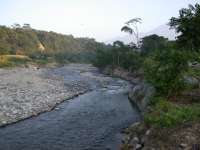 |
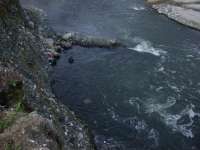 |
| Border Mountain | Border River | River Garbage |
We head to Guatemala City in luxury, air conditioning and movies that are better than on the planes. We pass a washed out bridge from some previous flood.
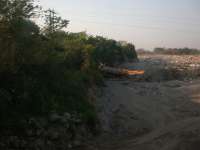 |
| Washed out Bridge |
I spend the night in Guatemala City, then take a bus to the Rio. I hitch a ride down the river with Maria, who works at Bruno's marina. We make it to Gringo Bay, but the motor won't disengage, so we do some doughnuts, sending waves around the bay. Maria gives up on the throttle and gearshift and kills the engine, and we paddle up to Malakii, where I unload my gear and hop aboard, happy to be at the end of this part of the journey. Jennifer comes out to greet us and we all go to her place. Maria phones home, and I relax.
Gringo Bay, properly known as Bahia de Buena Vista, the Bay of the Beautiful View, is a wonderful quiet place. At night, I'd doze off with the sound of fish splashing and frogs croaking. I would wake up every morning to the sound of parrots flying over. Or Ibis croaking. They croak like frogs. Not very romantic for such a pretty bird. If it's a nice day, the view across the bay with a few boats on their moorings is always pleasing.
 |
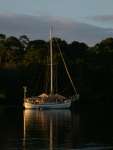 |
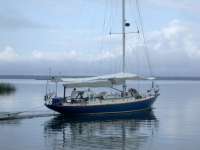 |
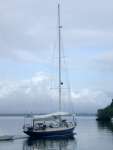 |
| Gringo Bay | Boat in Gringo Bay | Mustang | Mustang |
I spent the next month doing projects and enjoying just being alive.
I rediscovered fireflies. We don't have them up here in Montana, and they are a treat.
The first project was to put in a new cabin light, a bright fluorescent that makes reading easier and doesn't use anywhere near as much power as the old ones. It's even made by a small paw and maw shop here in Montana!
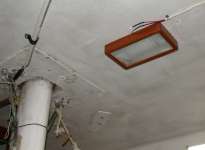 |
| Cabin Light |
I keep a journal when I'm on a trip; I wrote some of this in the cockpit by the light of the cockpit fluorescent. It's a weird light. Hanging vertically, it looks like the gas is spinning in circles around the cylinder; the light flickers. Cool... It's dead calm, lots of cricket noise, fish jumping, bullfrogs in the distance. Peaceful all around.
I found a note somewhere I'd written from a trip a few years ago to Minneapolis. Sign in North Dakota town at an intersection: "Red means STOP. Entering enforcement area." Do they not enforce it in other areas?
It rained quite a bit; enough to fill the tanks and then some. Sometimes after a rain the sun would poke through and light up the little island marking the entrance to the bay. There is a range of mountains across the lake, but you can't see it in the picture; they are obscured by clouds.
 |
| Island Marking Gringo Bay Entrance |
All that humidity takes its toll. Turns out plastic food packaging is not impermeable to moisture. Rice bought in Belize eight months ago, unopened, spoiled. Crackers bought in Rio Dulce ten months ago are soft. All the bristles on my paint brushes except for a synthetic one rotted in the past year.
I could probably learn something from parrots. They're not particularly good looking. They're fat. They aren't graceful. They fly like blimps, flapping like crazy, and barely staying in the air. They don't have a pleasant voice. They scrawch like they're hoarse. Yet they always show up in pairs. And they look like they have a marvelous time at it, flapping together like crazy, squawking back and forth, going wherever they're going. Having a grand time going through life day by day, every day, together.
One morning I awoke to find the boat covered with spider webs.
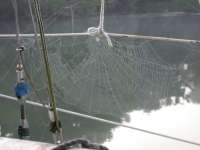 |
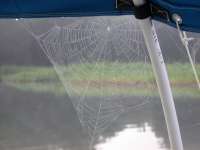 |
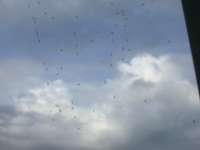 |
| Spider Web | Spider Web | Spider Food |
While I was working in the cockpit one afternoon a big (about 4-5" span) spider blew / floated in beside me. I moved away, not knowing anything about it. But I didn't want it living on the boat... Tried once to flick it overboard, fat chance. It was fast. I was afraid I'd lose it if I went below to get something to capture it with. So I killed it. So much for me being tolerant of insects.
The first big project was to upgrade my solar panel. I removed my old one from the dinghy davits, and installed two new (used) ones I bought from Brian and Christine on Mustang. The two panels should give me enough juice to run the fridge. I had two more panels, but couldn't find a place to mount them, so I ended up selling them. If I need more juice I'll get a small wind generator. That will give me some diversity, and a big boost in power, even at night when there's a breeze or I'm under way.
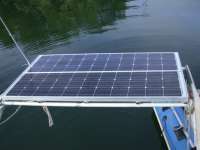 |
| New Solar Panels |
The neighborhood kids were always fishing from their cayucos. I don't know if they ever caught anything, but I'm sure they had a good time.
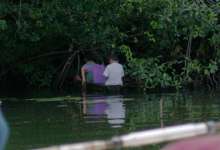 |
| 3 Boys in a Cayuco |
I met Jennifer's new neighbors, a young Austrian couple, Manfred and Andrea. They have bought land west of Jennifer and are busy building a place to work and storage space, preparatory to building a house on pilings. A young German, Marcos, has bought the ground on the other side of her. All of them sailed here from Europe on small boats they built themselves.
Some days I'd go down to the Rio Lampara with Bob Polk, on Foole, or Jennifer, or Manfred and Andrea. We usually would stop to see Chris and Aska, another young couple who have built a really cool house in no time, and are building bungalows nearby. It's amazing what can be accomplished with hand labor. Even more mind boggling is that fill, usually sand, is brought in by cayuco, hand dredged, filled to the gunwhales, then emptied by hand. A yard at a time, one yard a day; two if you're really making progress. Chris and Aska hope to be open for bed-and-breakfast type visitors by summer. It would be a great place to hang out for a few days. I'll try to get some pictures next time I'm down there. One day on the way back we stopped for a soak / swim at the hot spring along the side of the river. Aska and Chris met us there. The water was warm, and we watched a firey red sunset as the sun went down behind Cerro Sanchil, the mountain behing Gringo Bay.
One day I went over to Manfred and Andrea's to help them with one of their projects. On the way back I stuffed my glasses in my hat and jumped out of the dink, then kick-pushed it back to the boat. I grabbed my hat and was standing on the boarding ladder, and flipped my hat onto my head. I heard a funny ker-plunk, and looked at the water... Fortunately the sun was out, and I realized I didn't have my glasses on, and that sparkly thing in the water sinking was probably my glasses. I couldn't see them at all, just a vague impression, but fortunately my first grab connected with them. Whew! I couldn't tell they were my glasses until I had both hands on them and could feel them and lifted them out of the water and could look at them.
Every few days we'd get together for dinner, usually at Jennifer's. One evening when talking to Andrea I realized again how well off the average American is. One of the big appeals of Guatemala to Manfred and Andrea is that they can afford land here, a place of their own. "There's no way we could afford this in Austria." And it is only swamp land. Pretty, and on the lake, but still difficult to build and live on.
The dinghy floorboards were about shot. They were made of plywood, and the varnish didn't keep water completely out. Since they were often under water for long periods of time, they ended up delaminating. I had Inmar, a local boatbuilder, make me some new ones out of solid fiberglass. They're great, although a bit heavier than the old boards.
 |
| New Dink Floorboards |
I permanently mounted the SSB and its associated antenna tuner, and strung a new antenna. Unfortunately, the new antenna was a bit short, and doesn't work well, so I'll have to redo it.
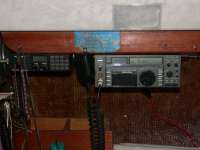 |
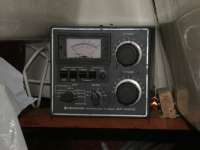 |
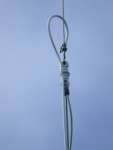 |
| SSB Transciever | SSB Antenna Tuner | SSB Antenna |
But the big project was the ice box to refrigerator conversion. It was a project much like the bus ride.
The plan was to buy some blue board (2" thick rigid closed cell foam), and cut it to fit the inside of the existing ice box, thereby adding insulation. Then fiberglass over that, making the new refrigerator a bit smaller than the old ice box, but much better insulated. Then mount the evaporator and condensor/compressor unit and I'd be in business.
For starters, nobody sold closed cell foam. There wasn't any around anywhere, probably because it's warm in Guatemala, construction standards are non-existant, and basements generally don't exist. I gave up and got some 1/4" plywood, really flimsy 3-ply stuff, probably balsa cored. I cut it into pieces to frame up the inside of the smaller box. Unfortunately, some of the pieces had to be themselves done in pieces, as the whole piece wouldn't fit through the existing ice box opening. Then I cut fiberflass mat to match all the pieces, and spent two days mixing resin and turning the cheap plywood pieces into fiberglass covered pieces, where the wood served primarily as a form. In retrospect, I probably should have peeled the wood off after the fiberglass cured, but I didn't.
Then I bought all the expanding spray foam in town... all three cans of it. One by one, I took each piece for the inside of the new box and sprayed it with expanding foam, then slipped it inside the ice box and into place. I wedged various pieces of wood and pvc pipe to keep the pieces from being pushed further in as the foam expanded, and hopefully squeeze the foam uniformly around behind the panels.
Unfortunately, my three cans of foam only got me half way through the project. I managed to find some two part liquid expanding foam from another boater. You mix it together and it goes crazy, heats up, and makes foam. I got a quart of each part, which seemed like it should be more than enough. It was a royal pain in the butt to use, as it was difficult to mix and spread, and didn't expand as much as the stuff in the cans. But I got the rest of the panels installed.
When that was done, I had the basic box the way I wanted it, but there were still some air spaces around the joints. If I had had more foam in cans, it would have been a simple matter to fill the voids. But I didn't, and the stores hadn't gotten any more in. All I had was the two part liquid stuff. So I ended up mixing it in small quantities, sucking it part way up a clear plastic tube, and blowing it back out into the voids. I could only get two or three sucks in before the foam started to go off in the tube. Then I had to quickly run a coathanger through the tube, wait for it to set up, and clean it out for another use. It was particularly difficult doing the vertical joints and the seams on top. It took all day to do what would have taken a half hour with a can of foam. All I could think of while doing this was it was a good job to waste time if you were in prison, like digging a tunnel with a spoon.
Once I got everything foamed, I used fiberglass tape and resin to connect all the seams, It was a brutal job. Blech! It was hot and humid inside the boat; Sweat was streaming down my face and arms. The fumes were really bad, and I had to work with my head inside the ice box. I had the hatches open and the fans running for ventilation, but it didn't help a whole lot. I'd hold my breath, stick my head in the box, try to place a piece of sticky, resin coated fiberglass tape, and then come up for air. I had to redo about half of them, as I couldn't see very well and it was hard to get them placed properly and the ends smoothed down. I think it was fortunate that I had a stuffed up nose, but I'm not sure. At least psychologically, I had resin coated snot instead of a resin coated brain, and I could get rid of the snot. At last I was done, and I had a new, smaller, better insulated box.
When I tried to put the evaporator inside the new box, it was too large. I had measured and figured that it would fit, but the new foam job had added about 2-1/2" instead of 2" all around. I took the evaporator apart, cutting off the rivets that hold it together. Then I bent it to form a figure 8 instead of a simple oval. I think that will make the freezer space colder anyway, so that's good. I screwed the evaporator to the top of the ice box space, and ran the coolant tube over to underneath the stove. After connecting the thermocouple and associated control, the box proper was ready to go.
Then I built a small shelf for the compressor and condenser in the storage space under the stove, and mounted them on it. After connecting the evaporator to the compressor unit, I turned on the power and... Voila! a refrigerator!
I had to cut a hole in the cabinet door and install a screen behind it so the compressor got the proper flow of cooling air.
So far, I'm delighted with the new fridge. I haven't run it that much, but it only runs about 20% of the time, drawing about 4 amps.
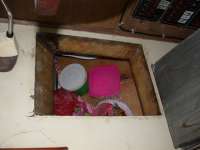 |
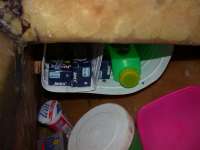 |
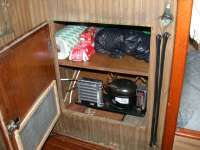 |
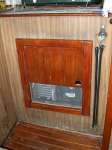 |
| Fridge | Fridge Evaporator | Fridge Compressor | Compressor Door |
It rained and drizzled all day on the solstice. I celebrated by setting off one of the roman candles I had bought on a trip to town. I wish fireworks were this cheap in the states! $12 for 3 roman candles and 10 rockets.
While cleaning up / rearranging all the junk in the cockpit one day I discovered a Central American Smooth Gecko, which I identified in my Belize and N. Guatemala wildlife guide. It says they are good in houses and eat lots of bugs, so I named it Sam and let him go on deck.
Bob from Foole and Richard Happy Face from La Vida Feliz and Jennifer and I celebrated Christmas at Jennifer's. After dinner I set off the some more fireworks. One roman candle didn't go.
I took my old solar panel over to Chico, Jennifer's guardian, and gave it to him as a Christmas present.
The next evening, I cut the roman candle back to where the balls were exposed, then lit it using the soldering torch. The first few didn't shoot very high, but once they were out and it had a bit of a barrel they went up ok.
After a hard days work I was usually pretty sweaty, particularly when I was working inside the icebox. So in the evening I'd usually jump in the lake for a bath and quick swim. The water is always warm, but it cools you off just right when you get out.
I finished the frig two days before I had to head home, and spent the next two days doing odd jobs.
I installed a radar reflector up the mast. Not as good as having active radar, better than conventional passive reflectors, and a lot better than nothing, which is what I had before.
 |
| Radar Reflector |
I put new varnish on some of the miscellaneous storage covers, the companionway stairs, the washboards, and handrails.
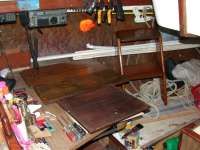 |
| Varnish work |
I had Marcos over for dinner a few days before I left, and he told me about some great trips he took to Venezuela and Bolivia.
In Bolivia -- the Rio Beni, a tributary of the Amazon. He went as far as he could by road, then hiked to a little village. Then bought for $1 a cast off balsa wood raft, 6" logs, 5-6 feet or less wide, 5 meters long. He paddled down on that, camping out by tieing up on the bank, rigging a hammock from A frame bamboo poles over the boat, and draping his mosquito net and tarp over the whole thing.
In Venezuela, there is a big savannah with mesas in the south, where the tallest waterfall in the world is. He was down there with his girl friend and his brother, and they floated the Rio Acanang down to Canayma. They took a bus to the end of the line, then hiked to a little village. There they hired guide to hike through jungle / forest (5 days) to the river, where there was a village with an old mission and a defunct mining operation. They built a raft of cast off 55 gallon drums. A whole one on each end, broadside, and 3 others butterflied open like books in the middle; poles along the sides, lashed and laced using a hammer and nail for a punch and wire from some old generators for lashing. What an adventure!
Marcos also took some great train rides in Peru or Ecuador. Guayaquil, Quito, narrow gauge; busses fitted with train wheels. Took a train up north from someplace to the Pacific, then went down the Pacific coast by road to Guayaquil, then took the train to Quito. Then backtracked on the train part way, and continued south in the mountains.
So much to see, so little time.
Then I headed back up the river, caught a bus to Guatemala City, and a plane back to Denver via Dallas for a short rest. While changing planes in Dallas, I stopped by a money exchange place. The DFW exchange rate for quetzales is 6.40, compared to 7.50 in the Guatemala airport. Talk about greedy capitalists!
In Dallas, the woman at the gate announced that my flight had no meal service; it was beverage service only, but "You are welcome to bring any food items of your choice." My immediate thought at the time, after traveling the past month on Guatemalan busses and boats where there seemed to always be at least one live chicken in a carry-on bag,... oh, never mind. Maybe that's why the unattached woman a few seats away in the waiting area never once looked at me.
In Denver, mom taught me to make the best chocolate candy in the world.
 |
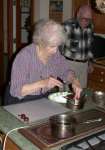 |
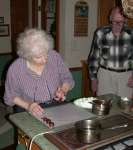 |
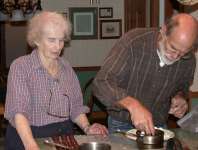 |
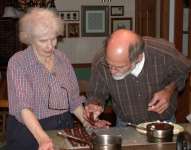 |
| Making Fudge |